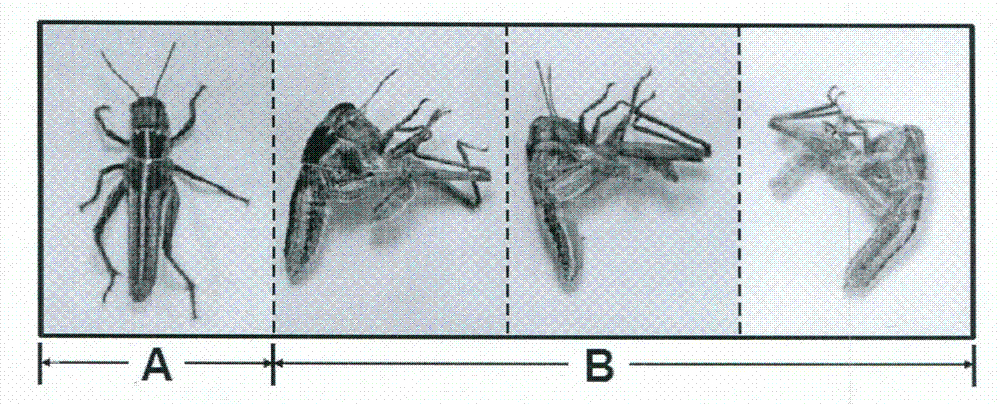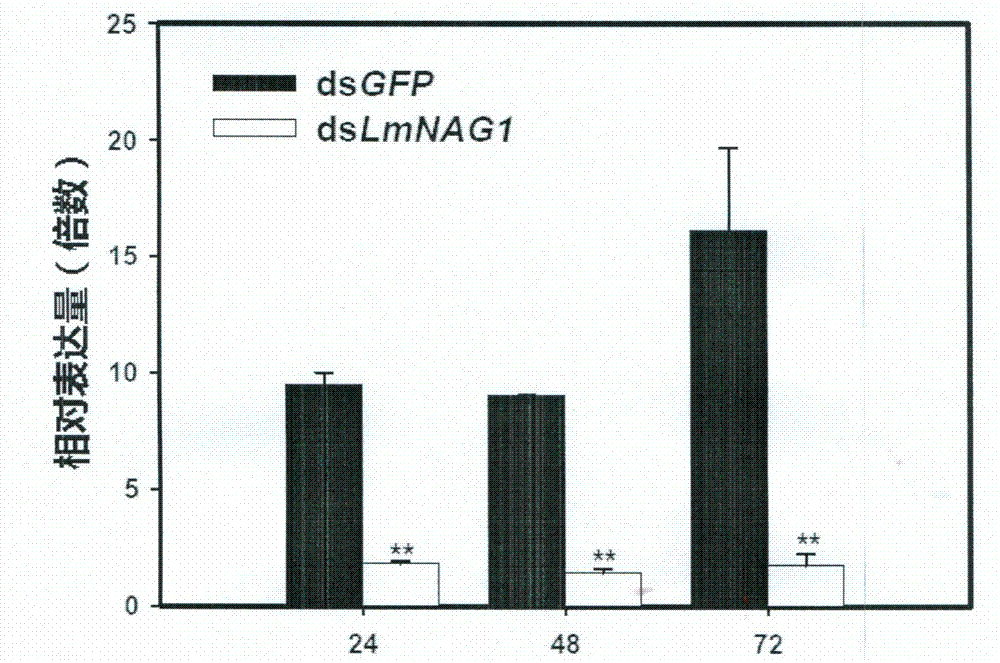Beta-N-acetylglucosaminidase genes of insects and application thereof
A technology of glucosidase and acetylaminosidase, which is applied to the application field of insect β-N-acetylglucosaminidase gene sequence and dsRNA, can solve the problems of increased control cost, slow effect, toxic pesticides harming human health and the like
- Summary
- Abstract
- Description
- Claims
- Application Information
AI Technical Summary
Problems solved by technology
Method used
Image
Examples
Embodiment 1
[0012] Embodiment 1: Obtaining of migratory locust β-N-acetylglucosaminidase gene fragment and dsRNA thereof
[0013] 1. Acquisition of β-N-acetylglucosaminidase gene fragment of migratory locust
[0014] 1) Search of migratory locust β-N-acetylglucosaminidase gene in migratory locust expressed sequence tag EST database
[0015] Based on the expressed sequence tag (EST) database of migratory locusts, bioinformatics methods were used to search the β-N-acetylglucosaminidase genes of migratory locusts. After sequence analysis and comparison, a total of 17 migratory locusts β-N -A fragment of the acetylglucosaminidase gene. After splicing, the obtained migratory locust β-N-acetylglucosaminidase gene (LmNAG1) sequence has a full length of 2667bp and an open reading frame of 1845bp.
[0016] 2) Design of primers for migratory locust β-N-acetylglucosaminidase gene
[0017] Based on the obtained base sequence of LmNAG1, primers were designed using primer premier5.0 software. All p...
Embodiment 2
[0031] Embodiment 2: migratory locust β-N-acetylglucosaminidase gene dsRNA kills 2 instar migratory locust
[0032] 1. Injection of migratory locust β-N-acetylglucosaminidase gene dsRNA
[0033] 1 μl (3 μg) of dsRNA of SEQ ID NO: 2 was injected with a 25 μl micro-syringe between the second and third abdominal segments of the second-day-old nymphs of the 2nd-instar migratory locust, and a total of 30 were injected, half male and half male. Inject dsGFP at the same volume concentration into the control group. The injected migratory locusts were raised in a constant temperature biochemical incubator at 28°C.
[0034] 2. Observation of the phenotype of the 2-year-old migratory locust after injection of dsRNA
[0035] After the 2nd instar nymphs were injected with dsRNA, 3 days after the injection of dsGFP the control group began to molt and all successfully molted to the third instar. The average molt time was 15-20 minutes. eat. There were 30 nymphs in the treatment group inj...
Embodiment 3
[0036] Embodiment 3: Migratory locust β-N-acetylglucosaminidase gene dsRNA kills 5th instar migratory locust
[0037] 1. Injection of migratory locust β-N-acetylglucosaminidase gene dsRNA
[0038] 2 μl (6 μg) of dsRNA of SEQ ID NO: 2 was injected with a 25 μl microinjector between the second and third abdominal segments of the 2nd-day-old nymphs of the 5th instar migratory locust, and a total of 40 were injected, half male and half male. Inject dsGFP at the same volume concentration into the control group. The injected migratory locusts were raised in a constant temperature biochemical incubator at 28°C.
[0039] 2. Observation of the phenotype of the 5th instar migratory locust after injection of dsRNA
[0040] After the fifth instar nymphs were injected with dsRNA, the worms in the control group began to molt 3 days later and all successfully developed into adults on the 5th day after injection. The molting time was about 20 minutes, and the worms in the control group were...
PUM
 Login to View More
Login to View More Abstract
Description
Claims
Application Information
 Login to View More
Login to View More - R&D
- Intellectual Property
- Life Sciences
- Materials
- Tech Scout
- Unparalleled Data Quality
- Higher Quality Content
- 60% Fewer Hallucinations
Browse by: Latest US Patents, China's latest patents, Technical Efficacy Thesaurus, Application Domain, Technology Topic, Popular Technical Reports.
© 2025 PatSnap. All rights reserved.Legal|Privacy policy|Modern Slavery Act Transparency Statement|Sitemap|About US| Contact US: help@patsnap.com



